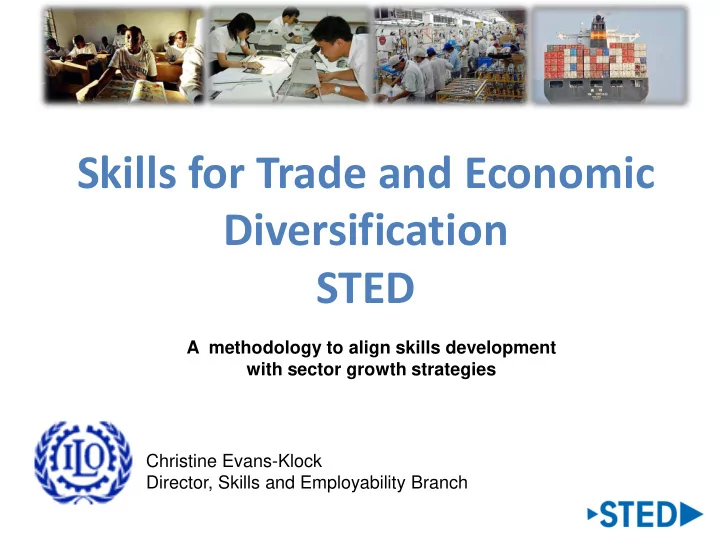

Skills for Trade and Economic Diversification STED A methodology to align skills development with sector growth strategies Christine Evans-Klock Director, Skills and Employability Branch
ILO’s mandate on skills development, set through tripartite consultations of Governments, Workers and Employers: Help constituents bridge the world of education and training to the world of work in order to… improve the employability of workers, increase the productivity and competitiveness of enterprises, and expand the inclusiveness of economic growth
Countries sustain a “virtuous circle,” linking education, skills, and decent work by… 1. ensuring the broad availability of quality education 2. matching supply to current demand for skills 3. helping workers and enterprises adjust to change 4. sustaining a dynamic development process: Using skills as a driver of change to move from lower to higher productivity 5. expanding accessibility of quality training: smaller enterprises, rural areas, women, disadvantaged youth, persons with disabilities HOWEVER... The benefits of training are not realised without job-rich growth
Skills for Trade and Economic Diversification (STED) Methodology for ILO support to constituents based on data analysis and social dialogue to: 1) identify sectors with potential to increase exports, diversify the economy, and create productive and decent work; 2) assess skill needs and training gaps along their value chains; 3) agree plans on how to meet training needs: policies, institutions, enterprises, clusters and value chains; and 4) build up institutions to sustain employer engagement with training institutions and improve accountability.
STED methodology identifies skill gaps in target sectors STAGE 1: STAGE 4: STAGE 2: STAGE 3: STAGE 5: STAGE 6: Sector How many Capability What Type Skills Supply Proposed Position and Workers by Implications of Skills? Gap Responses Outlook Skill Type?
STED Methodology: economic analysis & social dialogue • Build capacity of national research institutions Data analysis, consultations • Identify export potential sectors; assess skills needs • Ministries, Employers, Workers, Trainers validate Stakeholder sectors, assess value chain, discuss skill gaps workshop • Data analysis, local field research, lessons elsewhere Draft report – • 2 nd stakeholder workshop finalizes findings, ILO & national institutions disseminates research; drafts recommendations • Follow-up: industry skill councils, training programs, Final report labour market information, broader trade debate
STED from research to action Armenia, Kyrgzystan, Tajikistan Kyrgyzstan Macedonia Year: 2011 Year: 2011 Sector: Garments Sectors: Tourism, Food Processing Ukraine Year: 2010 Viet Nam Jordan Sectors: Metal Industry, Tourism Aid for Trade: Tunisia , Egypt Aid for Trade: Lebanon, Bangladesh Oman Year: 2011 Sectors: Agro Processing, Pharmaceuticals STED agreed with constituents STED features in Russia-funded within the Aid for Trade Initiative project to extend the outreach of for Arab States the G20 Training Strategy
Kyrgyz STED Highlights – Sida funded study • Skills just one of the key barriers to success of garment sector • Outward migration an important factor • Different views on expected impact of Customs Union • Gaps: business strategy on higher productivity and higher skills for international competitiveness better quality at lower level skills – machinist etc. key services: technical, marketing, design, logistics • Reform of TVET for priority garment industry could lead to wider TVET reform • TVET reform will not lead to more and better jobs without reform of enterprise strategy, production systems and management
Lessons learned: Coordination is critical to close the gaps … basic education, vocational training, and the world of work … training providers and employers at sector and local levels … skills development and trade, industrial, technology and environmental policies Avoid skill gaps today and drive economic and social development tomorrow.
THANK YOU Today’s presentations and STED studies available on the Global public-private Knowledge Sharing Platform on Skills for Employment at http://www.skillsforemployment.org
Recommend
More recommend